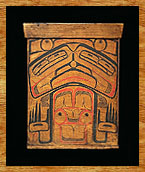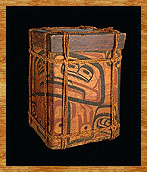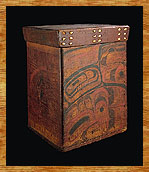(page 1 of 2)
 Boxes and Boxes and
 Chests Chests
 Basketry Basketry
 |
Boxes and Chests
Boxes were used to store food stuffs, clothing, regalia and ritual paraphernalia such as rattles and whistles. Some boxes were simply made of bent sheets of cedar bark sewn at the corners and base to provide disposable containers for trade items, while others were more substantial and durable bentwood boxes. Bentwood boxes for food ranged in capacity from a couple of litres (quarts) up to 225 L (50 gallons). George M. Dawson observed that boxes of eulachon grease brought to the islands for trade by the Tsimshian required two men each to pack them up the beach from the canoes.

 |
Food storage boxes were usually not decorated, but occasionally one such as this example was painted with the image of the supreme Chief of the Seas, the being ultimately responsible for all of the other sea creatures that the Haida used for food. Their flesh was under its guardianship while in such a box, which in turn honoured that supernatural being.
Collected at Masset circa 1895 by Charles F. Newcombe.
CMC VII-B-324 (S92-4198) |

Bentwood storage boxes destined to store important wealth objects were provided with a guardian spirit decoration in the form of supernatural marine beings and more familiar animals. They also had heavy plank lids, whose edges were decorated with vertical rows of opercula shells. The lids were tied in place with elaborate knotwork of cedar bark cordage.

 |
This painted bentwood storage box shows the typical lashing and knotwork of twisted cedar bark cordage used to secure the contents during transport in freight canoes.
Collected on Haida Gwaii before 1901 by Charles F. Newcombe.
CMC VII-B-929 (S94-6759) |

The design field of a bentwood box has provided a constant challenge for art historians and native scholars alike to interpret. Although the design is standard, the variations are endless and intriguing. The "front" of the box normally depicts Konankada (the Chief of the Undersea World), with fins as well as human hands. The face has double-eye forms (two salmon heads joined at the nose). The "back" of the box is a variation of this creature with single-pupil eyes. This supernatural being may be modified by the addition of such markers as large incisors (Beaver), gill slits (Dogfish), large canines (Wolf), tall ears and protruding tongue (Bear), and so on. The side panels of the box have much simpler designs, which are only painted and not carved.
A variation of the standard box design is to spread the traditional front and back image of the supernatural being over the two sides of the box, so that its protective power is continuous around the box.


[ view 1 ]
[ view 2 ]
[ view 3 ] |
The unusual decoration on this bentwood storage box displays the idiosyncratic style practised by some Skidegate Inlet artists towards the end of the nineteenth century.
From the Lord Bossom collection.
CMC VII-X-621 (S94-6786 to -6789) |

Some box designs defy a simple analysis. They do not relate to a supernatural guardian figure but use multiple elements, including human faces manipulated freely. Franz Boas challenged Charles Edenshaw to provide an interpretation for such a box, which is now in the collection of the American Museum of Natural History in New York City. Edenshaw provided an explanation of each panel as part of a Raven myth, but few others have been able to comprehend the shorthand interpretation of the visual symbolism he provided. Bill Reid refers to this box as "the final exam" in understanding Northwest Coast art. Few manage to pass that exam.
|